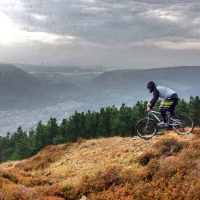New tyres 27.5+ reducing tyre size
Muise
Posts: 12
Hi,
This is my current setup (all factory spec - running tubeless). I am finding the tyres are too big for my riding. I mainly ride XC/trails. I would like to get some smaller tyres but could do with some help:
1. Are the rims compatible with smaller tyres (or are they 'plus' specific)?
2. Which tyres would you recommend? I ride in the new forest so mainly gravel/sand/mud terrain, relatively flat with short ups and downs but the downs are often stoney and lots of tree roots at high speed.
Any advice gratefully received.
Hub Front Syncros TR2.0 Plus CL / 15x110mm made by DT Swiss
Hub Rear Syncros TR2.0 Plus CL / Boost 148x12mm RWS axle / made by DT Swiss
Rims Syncros XR2.0 Plus / 28H / 35mm Tubeless ready
Spokes DT Swiss Competition 2.0-1.8-2.0 Black
Tyres Front: Maxxis Minion DHF 2.80 x 27.5 / 3C Maxx Terra | Rear: Maxxis Rekon 2.80 x 27.5 3C / Maxx Speed 120TPI Kevlar Bead / EXO / TR Tubeless ready
This is my current setup (all factory spec - running tubeless). I am finding the tyres are too big for my riding. I mainly ride XC/trails. I would like to get some smaller tyres but could do with some help:
1. Are the rims compatible with smaller tyres (or are they 'plus' specific)?
2. Which tyres would you recommend? I ride in the new forest so mainly gravel/sand/mud terrain, relatively flat with short ups and downs but the downs are often stoney and lots of tree roots at high speed.
Any advice gratefully received.
Hub Front Syncros TR2.0 Plus CL / 15x110mm made by DT Swiss
Hub Rear Syncros TR2.0 Plus CL / Boost 148x12mm RWS axle / made by DT Swiss
Rims Syncros XR2.0 Plus / 28H / 35mm Tubeless ready
Spokes DT Swiss Competition 2.0-1.8-2.0 Black
Tyres Front: Maxxis Minion DHF 2.80 x 27.5 / 3C Maxx Terra | Rear: Maxxis Rekon 2.80 x 27.5 3C / Maxx Speed 120TPI Kevlar Bead / EXO / TR Tubeless ready
1
Comments
-
There are recommendations (not rules) for minimum and maximum width tyres that can be fitted to wheels based on the internal width of the rims.
e.g. I run 30mm internal width rims with 2.4 inch tyres. A Buddy runs 3.0 inch wide tyres but with 40mm internal width rims on all kinds of off road terrain including mud, roots rocks etc. which suits our xc/trail riding fine.
Different width tyres on different width rims changes tyre profile and if combinations are too far away from the recommendations they could have a negative effect on handling and the tyres staying on the rim when pushed hard into a corner for example. Tyre pressure is also a factor to consider.
Have a read of this article it will help explain what different tyre and rim width combos does to tyre profiles, the effects and some general recommendations.
https://www.singletracks.com/mtb-gear/can-i-run-a-wide-tire-on-my-rim-mountain-bike-rim-widths-de-mystified/
1 -
What do you think is too big about your tyres ?
Nothing worse than faffing around mounting different tubeless tyres to realise your original ones were better than you thought.0 -
2.8" tyres sound perfect for the terrain in the New Forest, especially the sandy and gravelly bits.
Have you tried experimenting with diferent tyre pressures? That can make a huge difference and costs nothing.
What pressures are you currently running the tyres at?
“Life has been unfaithful
And it all promised so so much”
Giant Trance 2 27.5 2016 ¦ Sonder Broken Road 2021¦ Giant Revolt Advanced 2 2019 ¦ Giant Toughtroad SLR 1 2019 ¦ Giant Anthem 3 2015 ¦ Specialized Myka Comp FSR 20090 -
The rim spec you gave was:
"Rims Syncros XR2.0 Plus / 28H / 35mm Tubeless ready"
That implies 35mm internal rim width to me, which is a much better fit to a 2.8" tyre.
reaper said 20mm is "quite narrow". In fact 20mm would be completely wrong for such a wide tyre as 2.8" (71mm).
See the WTB charts in the following link. (Page down to the mountain bike chart".
https://www.wtb.com/pages/tire-rim-fit-chart
According to the chart, a 35mm internal rim width is ideal for 55-72mm (2.2" to 2.8"). You could go narrower, down to 4mm (1.9"), but with some compromise.
But as JBA says, it costs nothing to experiment with tyre pressures, so see how low you can go as well as just going high to reduce rolling resistance. A tyre that has pressure low enough to allow the tyre to conform to the the trail will have lower rolling resistance over rocks and roots than if it were pumped up. If the tyre is hard it bounces off the rocks and roots and actually slows you down. Only on smooth surfaces do higher pressure tyres do better.
PS: I ride in very similar terrain to you with 292.6" tyres and I find them very good. I have also ridden in the same area for years on 27.5x2.2" tyres and they were also very good. Totally different bike though.
0 -
Didn't see much info on inner diameter and missed the 35mm in the initial description. I saw this clip and the guy read this off the rim itself. This was my reference but obviously was for a different rim. I've edited my previous post, thanks for the heads up Steve! 👍steve_sordy said:The rim spec you gave was:
"Rims Syncros XR2.0 Plus / 28H / 35mm Tubeless ready"
That implies 35mm internal rim width to me, which is a much better fit to a 2.8" tyre.
reaper said 20mm is "quite narrow". In fact 20mm would be completely wrong for such a wide tyre as 2.8" (71mm). https://youtu.be/gu3AHRh_Hzc
https://youtu.be/gu3AHRh_Hzc
0 -
Thanks all. I think I'm largely influenced by the fact that everyone I ride with comments on how large my tyres are (every single time!). It does feel like there is a lot of drag (especially on the flat - I struggle to keep up many of the other riders - despite having always been able to on my previous bike - they all have 2.3" tyres. They feel great for grip, but not for speed). I am running them around 21psi, I guess I could try upping that by 3 or 4 points? I'm about 78kg.0
-
My Buddy with 3 inch tyres gets a lot of ribbing, he keeps falling off following our lines and complains they're hard work when trying to keep up. We joke it's his massive monster truck tyres, maybe it is? Like us I'm sure the Guys you ride with are just having a little fun.
Wouldn't change based on what other people say but if you're struggling with pace then it's worth trying some narrower tyres.
2.5"-2.6" are ok but I don't like plus size tyres personally. I've never had grip issues or problems running with 2.4's.0 -
The video shown referred to Syncros XR 2.0. I'm no DT Swiss expert at all, but I suspect the missing "Plus" has a lot to do with the internal rim width difference.
Trying to keep up with other riders on relatively smooth surfaces when they have narrower tyres is tricky, until the trail gets rough and points down. The other absolutely key factor on monster truck tyres is to get the pressure right.
But taking a bike with 2.8" tyres onto an XC trail and trying to compete with your mates on their skinnies is a losing proposition.0 -
Just for comparison. At a rough estimate, my bike will be 7kg heavier than yours. In addition, my riding weight is 92kg. So approximately my tyres are carrying 21kg more than yours. (46lbs in old money).Muise said:................. - I struggle to keep up many of the other riders - despite having always been able to on my previous bike - they all have 2.3" tyres. They feel great for grip, but not for speed). I am running them around 21psi, I guess I could try upping that by 3 or 4 points? I'm about 78kg.
My tyres are 2.5" and yours are 2.8", so in theory, my pressures should be 12% higher than yours. Yet I ride with 17psi front and 20psi rear. This is what works for me in terms of grip, drag, ride feel, absence of squirm and burping etc. If i was going somewhere with a lot more rocks (bike park Wales for ex), I would put no more than another 1psi in each end. But during lockdown when I was riding mostly tarmac and towpaths I put 5psi in at at each end. I was faster for sure, but I would not have been faster on the rough stuff.
The exact tyre spec has a big influence and pressures are not easily scalable just on rider weight and tyre width. Next time out take a mini-pump and a digital tyre pressure gauge, like the Topeak D2. Start with a higher pressure and session a bumpy trail that also has bends and try lower and lower pressures. Keep going until you detect something you don't like then back off and put 1psi back in.
Do not be afraid to have different tyre pressures for different locations. Tyres are your first point of contact; they provide grip, braking and suspension. They give you the feel of the trail and the confidence to dive in to fast corners and steep descents. It is worth taking the time to establish tyre pressures that work for you.1 -
I had similar situation with my Stumpy which came with 2.6 front and back a colleague advised I should change rear to 2.3 which dealer done at no cost. I previously was a die hard hardtail rider, I am still riding same places but bike is certainly fast and not being held back by tires although I think front looks really big.So Far!0



